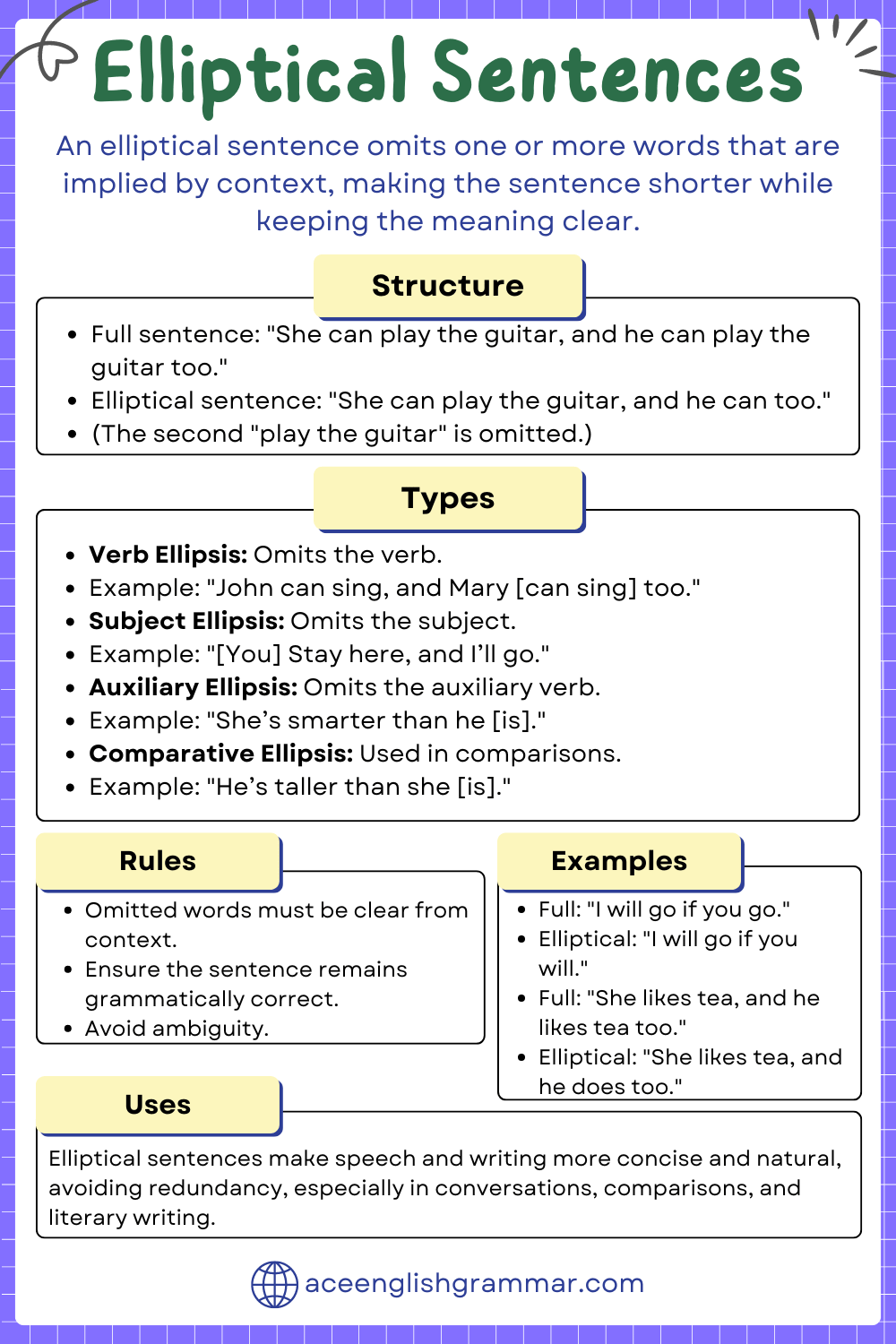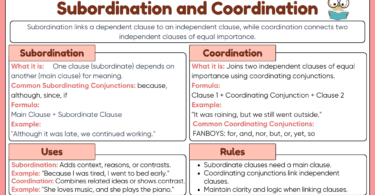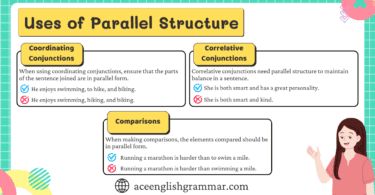In English grammar, elliptical sentence is a powerful tool used to make sentences more concise and fluid without losing meaning. Understanding elliptical sentence is essential for learners seeking to master sentence structure and enhance their writing skills. This article will explain the concept, structure, and use of elliptical sentences, providing examples to help you grasp the idea effectively.
Table of Contents
What is Elliptical Sentence?
An elliptical sentence is a sentence where one or more words are omitted because they are implied by context, but the sentence remains grammatically correct. The omitted words are usually redundant, and their absence helps to make the sentence shorter and more efficient without changing the overall meaning.
Example of Elliptical Sentence:
- Full sentence: “I can play the guitar, and she can play the guitar, too.”
- Elliptical sentence: “I can play the guitar, and she can, too.”
In this example, the second mention of “play the guitar” is omitted in the elliptical version because it’s already understood from the first clause.
Structure of Elliptical Sentences</h3>
<p><p>Elliptical sentences often rely on parallel structures where the missing words can be easily inferred from the context of the previous clause. These sentences can omit different elements, such as verbs, subjects, or auxiliary verbs.
Common Structures of Elliptical Sentences:</h4>
Verbs Omission:
- “She likes chocolate, and he does, too.”
(does replaces likes chocolate)
Omission of Subjects:
- “If you go, I will [go] too.”
Omission of Auxiliary Verbs:
- “She’s faster than I [am].”
Types of Elliptical Sentences</h3>
<p><p>Elliptical sentences can appear in various forms depending on what part of the sentence is omitted. Below are the most common types:
1. Verb Ellipsis:
The verb is left out but can be inferred from the previous clause.
- Example: “John plays the piano, and Mary [plays the piano] too.”
2. Subject Ellipsis:
The subject is omitted when it is clear from context.
- Example: “[You] Go left, and I’ll go right.”
3. Auxiliary Ellipsis:
The auxiliary verb is omitted.
- Example: “She can swim, and he [can swim] too.”
4. Comparative Ellipsis:
Used in comparisons, where the second part of the sentence omits the repeated elements.
- Example: “He is taller than she [is tall].”
Uses of Elliptical Sentences</h3>
<p>&lt;p>Elliptical sentences are often used in conversational English to make sentences sound more natural and less repetitive. They help in streamlining communication and avoiding redundancy.
Where Are Elliptical Sentences Commonly Used?
Everyday Conversations:
People naturally omit redundant information in daily speech.
- Example: “I’ll go if you will [go].”
Literary Writing:
Ellipsis adds variety and rhythm to writing, making it more engaging.
- Example: “He spoke of love, but she of fear.”
Comparative Statements:
Ellipsis is often used in comparisons to avoid repetition.
- Example: “She is smarter than I [am smart].”
Rules for
Using Elliptical Sentence</p>
- Context is Key: The omitted part must be easily understood from the context.
- Maintain Grammatical Consistency: Ensure that the ellipsis doesn’t make the sentence grammatically incorrect.
- Avoid Ambiguity: Only omit words when the meaning remains clear without them.</li>
Examples of Elliptical Sentences</h3>
Full Sentence: “You are taller than I am.”
Elliptical Sentence: “You are taller than I.”
Full Sentence: “She likes coffee, and he likes coffee, too.”
Elliptical Sentence: “She likes coffee, and he does, too.”
Full Sentence: “If he finishes, then I will finish.”
Elliptical Sentence: “If he finishes, then I will.”
Read More




